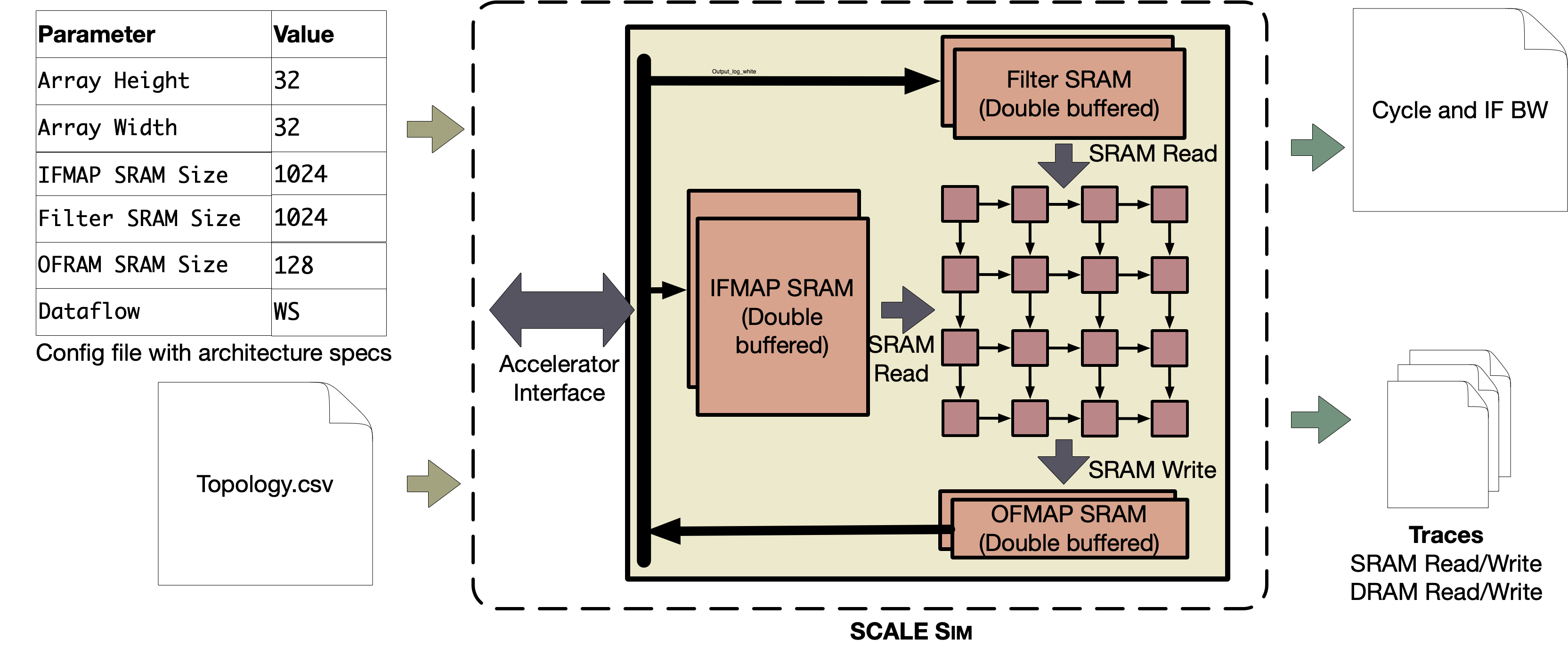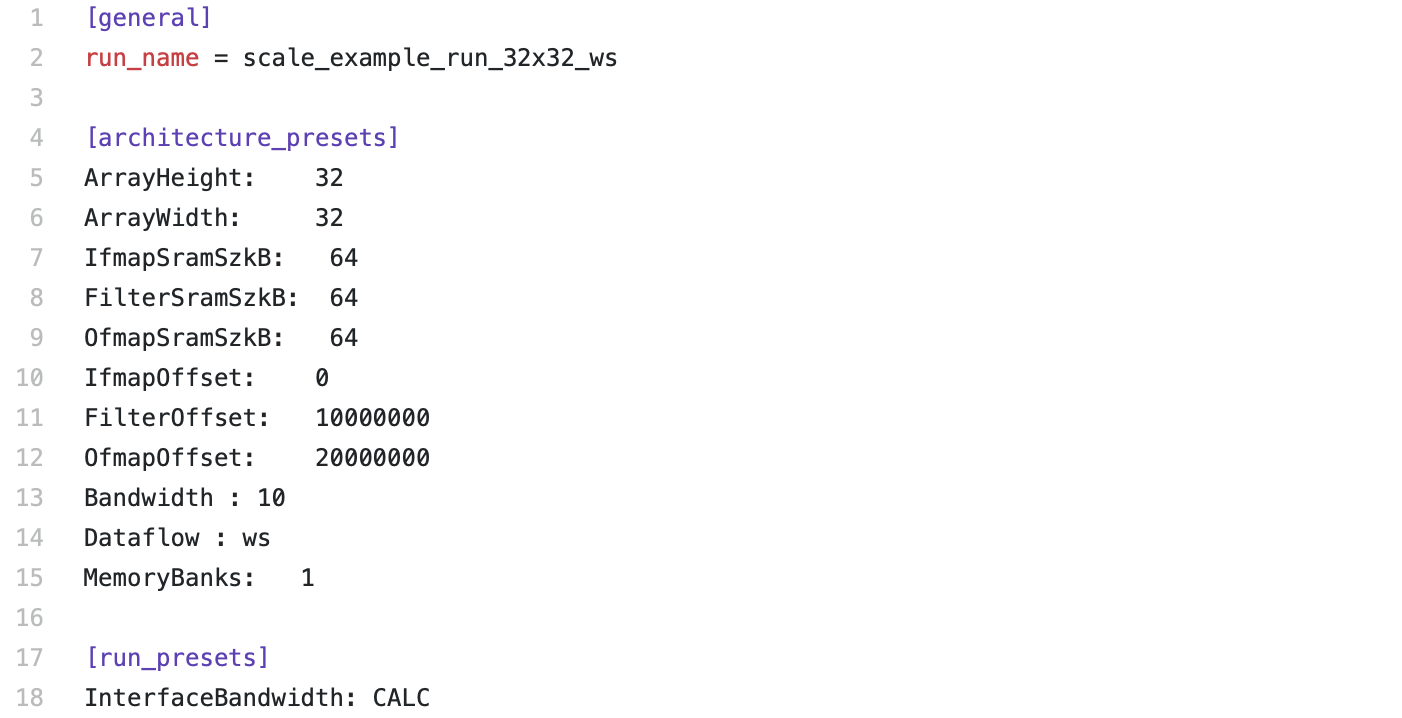SCALE Sim is a simulator for systolic array based accelerators for Convolution, Feed Forward, and any layer that uses GEMMs. This is a refreshed version of the simulator with feature enhancements, restructured code to aid feature additions, and ease of distribution.
Getting started is simple! SCALE-Sim is completely written in python and is available both as a package and could be run from source.
You can install SCALE-Sim in your environment using the following command
$ pip3 install scalesim
Alternatively you can install the package from the source as well
$ python3 setup.py install
SCALE-Sim can be run by using the scale.py script from the repository and providing the paths to the architecture configuration, and the topology descriptor csv file.
$ python3 scale.py -c <path_to_config_file> -t <path_to_topology_file> -p <path_to_output_log_dir>
The above method uses the installed package for running the simulator. In cases where you would like to run directly from the source, the following command should be used instead.
$ python3 <scale_sim_repo_root>/scalesim/scale.py -c <path_to_config_file> -t <path_to_topology_file>
If you are running from sources for the first time and do not have all the dependencies installed, please install them first using the following command.
$ pip3 install -r <scale_sim_repo_root>/requirements.txt
SCALE-Sim uses two input files to run, a configuration file and a topology file.
The configuration file is used to specify the architecture and run parameters for the simulations. The following shows a sample config file:
The config file has three sections. The "general" section specifies the run name, which is user specific. The "architecture_presets" section describes the parameter of the systolic array hardware to simulate. The "run_preset" section specifies if the simulator should run with user specified bandwidth, or should it calculate the optimal bandwidth for stall free execution.
The topology file is a CSV file which decribes the layers of the workload topology. The layers are typically described as convolution layer parameters as shown in the example below.
For other layer types, SCALE-Sim also accepts the workload desciption in M, N, K format of the equivalent GEMM operation as shown in the example below.
The tool however expects the inputs to be in the convolution format by default. When using the mnk format for input, please specify using the -i gemm switch, as shown in the example below.
$ python3 <scale sim repo root>/scalesim/scale.py -c <path_to_config_file> -t <path_to_mnk_topology_file> -i gemm
Here is an example output dumped to stdout when running Yolo Tiny (whose configuration is in yolo_tiny.csv):

Also, the simulator generates read write traces and summary logs at <run_dir>/../scalesim_outputs/. The user can also provide a custom location using -p <custom_output_directory> when using scalesim.py file.
There are three summary logs:
- COMPUTE_REPORT.csv: Layer wise logs for compute cycles, stalls, utilization percentages etc.
- BANDWIDTH_REPORT.csv: Layer wise information about average and maximum bandwidths for each operand when accessing SRAM and DRAM
- DETAILED_ACCESS_REPORT.csv: Layer wise information about number of accesses and access cycles for each operand for SRAM and DRAM.
In addition cycle accurate SRAM/DRAM access logs are also dumped and could be accesses at <outputs_dir>/<run_name>/ eg <run_dir>/../scalesim_outputs/<run_name>
We also recommend referring to the following papers for insights on SCALE-Sim's potential:
[1] Samajdar, A., Zhu, Y., Whatmough, P., Mattina, M., & Krishna, T.; "Scale-sim: Systolic cnn accelerator simulator." arXiv preprint arXiv:1811.02883 (2018). [pdf]
[2] Samajdar, A., Joseph, J. M., Zhu, Y., Whatmough, P., Mattina, M., & Krishna, T.; "A systematic methodology for characterizing scalability of DNN accelerators using SCALE-sim". In 2020 IEEE International Symposium on Performance Analysis of Systems and Software (ISPASS). [pdf]
If you found this tool useful, please use the following bibtex to cite the original creators of this tool:
@article{samajdar2018scale,
title={SCALE-Sim: Systolic CNN Accelerator Simulator},
author={Samajdar, Ananda and Zhu, Yuhao and Whatmough, Paul and Mattina, Matthew and Krishna, Tushar},
journal={arXiv preprint arXiv:1811.02883},
year={2018}
}
@inproceedings{samajdar2020systematic,
title={A systematic methodology for characterizing scalability of DNN accelerators using SCALE-sim},
author={Samajdar, Ananda and Joseph, Jan Moritz and Zhu, Yuhao and Whatmough, Paul and Mattina, Matthew and Krishna, Tushar},
booktitle={2020 IEEE International Symposium on Performance Analysis of Systems and Software (ISPASS)},
pages={58--68},
year={2020},
organization={IEEE}
}



